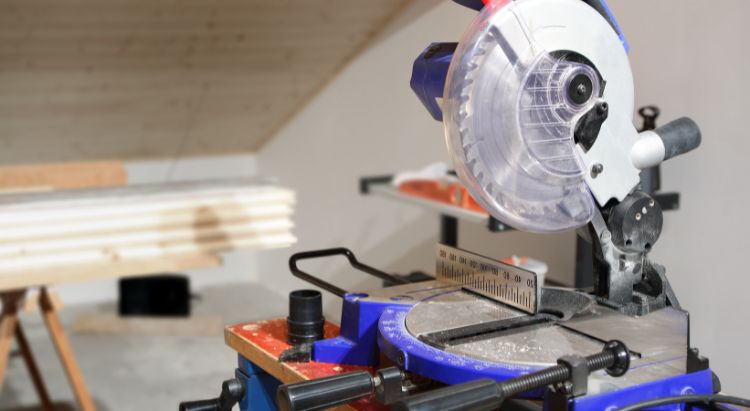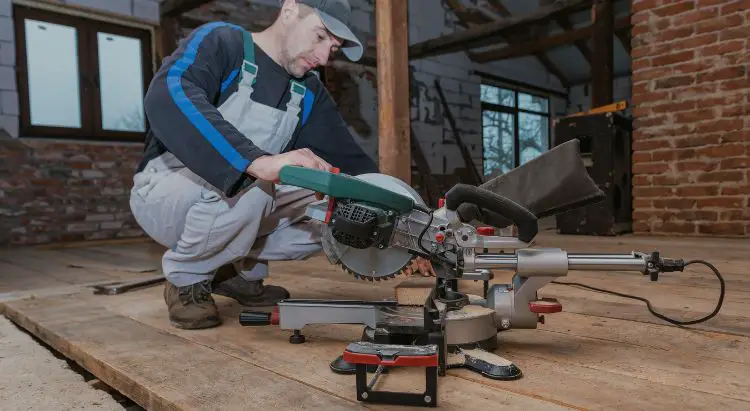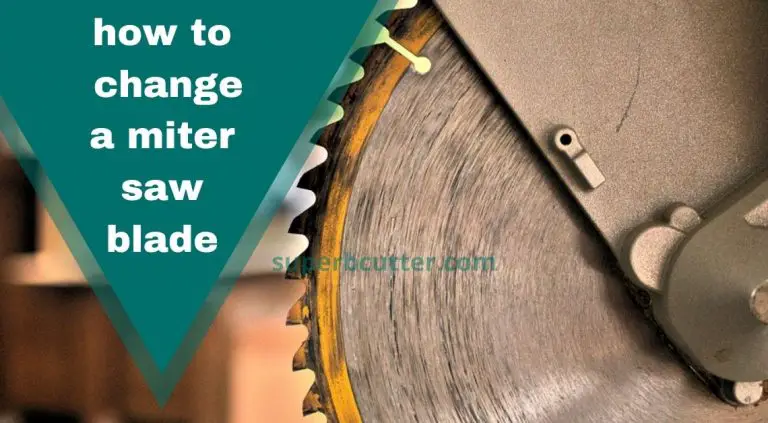Can You Cut Exhaust Pipe With A Miter Saw?
When making precise cuts on various materials, a miter saw is an essential tool for any DIY enthusiast or professional. But what about using a miter saw to cut exhaust pipes?
As car enthusiasts and DIYers alike know, cutting an exhaust pipe can be daunting and requires precision and expertise. However, with the right tools and knowledge, making accurate and clean cuts on an exhaust pipe with a miter saw is possible.
In this comprehensive guide, we’ll explore the world of exhaust pipes and miter saws and answer the age-old question:
Can You Cut Exhaust Pipe with A Miter Saw?
Join us as we dive into the nitty-gritty of this topic and uncover everything you need to know to cut an exhaust pipe using a miter confidently saw.

Understanding Exhaust Pipes:
Exhaust pipes are an essential component of any vehicle’s exhaust system, transporting exhaust gases from the engine to the tailpipe.
They come in various shapes, sizes, and materials, depending on the type of vehicle and the intended use.
Let’s explore the different types of exhaust pipes, the materials used in making them, and their dimensions.
Types of Exhaust Pipes:
Exhaust pipes can be classified into two main types: single and dual. A single exhaust system has one exhaust pipe, while a dual exhaust system has two pipes.
The single exhaust system is the most common type found in vehicles and is typically used in smaller vehicles.
Dual exhaust systems are mostly found in high-performance cars, allowing for better airflow, resulting in increased horsepower.
Materials Used in Making Exhaust Pipes:
Exhaust pipes can be made of various materials, the most common being stainless steel, aluminized steel, and mild steel.
Stainless steel is the most expensive material and offers the best corrosion resistance, making it ideal for performance vehicles. Aluminized steel is cheaper than stainless steel, offering good corrosion resistance and durability.
Mild steel is the most affordable material commonly used in OE (Original Equipment) applications. However, it’s not as durable as the other two materials and is prone to rust and corrosion.
Dimensions of an Exhaust Pipe:
Exhaust pipes come in various dimensions, including diameter, length, and thickness. The diameter of an exhaust pipe is the most critical dimension, as it determines the airflow that can pass through it.
The diameter of an exhaust pipe can range from 1.5 inches to 5 inches, depending on the vehicle’s engine size and performance requirements.
The length of an exhaust pipe can also vary depending on the vehicle’s layout and the number of bends required. The thickness of an exhaust pipe is essential for durability and can range from 14 to 18 gauge.
Understanding Miter Saws and Their Capabilities
A miter saw is a power tool commonly used for making accurate crosscuts and angled cuts in wood, plastic, and other materials.
It has a circular saw blade mounted on an arm, which pivots to make angled cuts. Let’s look at the different types of miter saws, the components of a miter saw, and the applications of a miter saw.
Types of Miter Saws:
There are several types of miter saws, each designed for specific cutting needs. The most common types include:
Basic Miter Saw: This is the most basic type of miter saw and can make simple angled cuts.
Compound Miter Saw: This type of saw can tilt in one direction, allowing it to make bevel cuts in addition to angled cuts.
Dual-Bevel Compound Miter Saw: This type of saw can tilt in both directions, making bevel cuts on both sides of the blade.
Sliding Compound Miter Saw: This type of saw can slide forward and backward, making wider cuts.
Components of a Miter Saw:
A typical miter saw consists of several key components, including the blade guard, miter gauge, bevel gauge, and fence. The blade guard is a safety feature that covers the blade when unused.
The miter gauge is a guide that allows the user to make angled cuts. The bevel gauge is a guide that allows the user to make bevel cuts. The fence is a guide that helps to keep the material in place during cutting.
Applications of a Miter Saw:
Miter saws are versatile tools that can be used for a wide range of cutting applications. They are commonly used in woodworking projects, such as framing, molding, and trimming.
They can also cut plastic, aluminum, and other materials. Miter saws are essential tools for DIY enthusiasts, woodworkers, and professionals.
Understanding a miter saw’s different types, components, and applications is essential when considering whether it can cut exhaust pipes.
While miter saws are versatile tools, it’s important to understand their limitations and the safety precautions to take when working with them.

Can You Cut Exhaust Pipe with a Miter Saw?
Cutting an exhaust pipe with a miter saw is possible, but several factors must be considered before attempting it.
In this section, we’ll explore the factors to consider, the advantages of using a miter saw for cutting exhaust pipes, and the safety precautions that should be taken.
Factors to Consider when Cutting an Exhaust Pipe with a Miter Saw:
Before cutting an exhaust pipe with a miter saw, it’s important to consider several factors, such as the material of the pipe, the diameter, and the thickness. Stainless steel exhaust pipes are the most challenging to cut and require special blades.
Additionally, the diameter of the pipe should be considered when selecting the blade, as it will affect the blade’s capacity to cut. Finally, the thickness of the pipe can also affect the cut, with thicker pipes requiring a more robust blade.
Advantages of Using a Miter Saw for Cutting Exhaust Pipes:
While using a miter saw to cut exhaust pipes has its challenges, there are several advantages to using this tool. A miter saw provides accurate and clean cuts, essential when working with exhaust pipes.
Additionally, a miter saw allows for precise angles, making it ideal for custom exhaust work. The miter saw also provides consistent cuts, ensuring the pipes have the same length and angle, resulting in a perfect fit.
Safety Precautions to Take When Cutting Exhaust Pipes:
Cutting exhaust pipes with a miter saw can be dangerous, and taking the necessary safety precautions is important. First, the operator should wear personal protective equipment, including eye and ear protection and gloves.
The work area should also be clean and free from any debris that may interfere with the cutting process. Finally, securing the exhaust pipe is essential to prevent it from moving during the cutting process.
Preparing to Cut an Exhaust Pipe with a Miter Saw
Before cutting an exhaust pipe with a miter saw, several steps should be taken to ensure a successful outcome. Let’s learn how to measure and mark the exhaust pipe, set up the miter saw, and choose the right blade for cutting exhaust pipes.
Measuring and Marking the Exhaust Pipe:
The first step in preparing to cut an exhaust pipe with a miter saw is to measure and mark the pipe.
Start by measuring the length of the pipe and determining the angle of the cut needed.
Once the angle has been determined, mark the pipe with a sharpie or marker to ensure accurate cutting.
Setting up the Miter Saw:
Once the exhaust pipe has been marked, the next step is to set up the miter saw. Begin by adjusting the blade to the correct angle.
Next, adjust the fence to ensure the pipe is supported and securely held in place during cutting.
It’s important to ensure that the pipe is flush against the fence and won’t move during the cutting process.
Choosing the Right Blade for Cutting Exhaust Pipes:
Choosing the right blade is crucial when cutting an exhaust pipe with a miter saw.
Using a blade specifically designed for cutting metal, such as a carbide-tipped or diamond blade, is recommended.
The blade should also be the appropriate size and thickness for the diameter and thickness of the cut pipe.
Cutting an Exhaust Pipe with a Miter Saw
Cutting an exhaust pipe with a miter saw can be challenging, but following a step-by-step guide can achieve a clean and precise cut.
In this section,I’ll provide a step-by-step guide on cutting an exhaust pipe with a miter saw and highlight common mistakes to avoid.
Step-by-Step Guide on Cutting an Exhaust Pipe with a Miter Saw:
- Start by measuring and marking the exhaust pipe, as discussed in the previous section.
- Set up the miter saw, ensuring the blade is at the correct angle, and the fence securely holds the pipe in place.
- Put on personal protective equipment, including eye and ear protection and gloves.
- Turn on the miter saw and slowly lower the blade onto the pipe, careful not to force it too quickly.
- Continue to cut through the pipe, using slow and steady pressure, until the cut is complete.
- Once the cut is complete, turn off the miter saw and remove the exhaust pipe.
- Inspect the cut to ensure that it’s clean and precise.
Common Mistakes to Avoid When Cutting an Exhaust Pipe with a Miter Saw:
There are several common mistakes to avoid when cutting an exhaust pipe with a miter saw.
First, avoid using a blade not designed for cutting metal, as this can result in a poor-quality cut and damage to the blade.
It’s also important not to force the blade through the pipe too quickly, as this can cause the blade to overheat and wear out quickly.
Finally, be careful not to cut too deeply into the pipe, which can affect its structural integrity and cause leaks.
Alternative Tools for Cutting Exhaust Pipes
While a miter saw is a popular tool for cutting exhaust pipes, several other tools can also be used. In this section, we’ll explore some alternative tools for cutting exhaust pipes and the pros and cons of using them.
Tools That Can be Used to Cut Exhaust Pipes Apart from a Miter Saw:
Angle Grinder: An angle grinder is a handheld power tool that can cut through metal, including exhaust pipes. It’s lightweight and portable, making it a convenient tool for cutting in tight spaces.
Hacksaw: A hacksaw is a handheld saw used for cutting through metal. It’s a simple and inexpensive tool that can cut through exhaust pipes, but it may take longer to make a cut compared to a miter saw or angle grinder.
Reciprocating Saw: A reciprocating saw, also known as a Sawzall, is a handheld power tool that uses a back-and-forth motion to cut through various materials, including metal. It’s a versatile tool that can be used for cutting exhaust pipes, but it may not provide the same level of precision as a miter saw.
Pros and Cons of Using Alternative Tools to Cut Exhaust Pipes:
| Tool | Pros | Cons |
| Miter Saw | – Provides precise and accurate cuts – Can cut through various materials – Offers adjustable angles for angled cuts – Easy to use with the right setup and technique | – May produce burrs – Can be difficult to use in tight spaces – May not be portable |
| Angle Grinder | – Portable and easy to use – Can cut through various materials – Provides a clean cut with minimal burrs | – Can be noisy and produce a lot of sparks – Can be difficult to control and may result in a less precise cut – Can be dangerous if not used properly |
| Hacksaw | – Inexpensive and readily available – Can cut through exhaust pipes and other metals – Provides a relatively clean cut | – Can be tiring to use and take longer to make a cut – May not produce a precise cut compared to a miter saw – May produce more burrs than other cutting tools |
| Reciprocating Saw | – Can cut through various materials, including exhaust pipes – Can be used in tight spaces – Can produce a relatively clean cut | – May not provide the same level of precision as a miter saw – May produce more vibrations and noise compared to other cutting tools – Can be difficult to control and may produce more burrs than a miter saw |
Miter Saw Vs. Chop Saw when Cutting Exhaust Pipe
When cutting exhaust pipes, two common tools that are often considered are miter saws and chop saws.
Both tools are designed to make precise cuts on various materials, including metals such as steel, aluminum, and copper.
However, some key differences between the two tools make one more suitable than the other for cutting exhaust pipes.
Miter saws, also known as drop saws or chop saws, are versatile power tools designed to make accurate crosscuts, angled cuts, and bevel cuts on various materials.
They are equipped with a circular blade mounted on a pivoting arm, which can be lowered onto the material to cut.
Miter saws can cut a wide range of materials, including wood, metal, and plastic, and are popular among carpenters, woodworkers, and DIY enthusiasts.
On the other hand, chop saws are specifically designed for cutting metals.
They are equipped with a powerful motor and a high-speed abrasive cutting wheel that can make quick and precise cuts through various metals, including steel, aluminum, and copper.
Chop saws are often used in metal fabrication, construction, and automotive repair.
So, which tool is better for cutting exhaust pipes?
The answer depends on a few factors, including the material’s thickness, the cut’s angle, and the precision required.
Here are some key differences between miter saws and chop saws when it comes to cutting exhaust pipes:
- Blade Size and Type: Miter saws typically have a smaller blade size than chop saws. The blade size on a miter saw can range from 7-1/4 inches to 12 inches, while chop saw blades typically range from 14 inches to 16 inches. Additionally, chop saw blades are designed specifically for cutting through metals, while miter saw blades are designed for a wider range of materials.
- The Angle of Cut: Miter saws are designed to make angled cuts, which are useful for cutting exhaust pipes at specific angles. On the other hand, chop saws are not as versatile for angled cuts, as they are typically used for straight cuts.
- Precision: Miter saws are known for their precision and accuracy when making cuts. They can make clean, precise cuts with minimal burrs or jagged edges. On the other hand, chop saws are designed for speed and efficiency, which means they may not produce the same level of precision as a miter saw.
In general, miter saws are a better choice for cutting exhaust pipes if you need to make angled cuts or require high precision.
They are also a good choice if you need to cut through other materials besides metals.
However, a chop saw may be a better choice if you are primarily cutting metals and need to make quick, straight cuts.
It’s important to note that regardless of which tool you choose, it’s important to take proper safety precautions when cutting exhaust pipes.
Always wear protective gear, such as safety glasses and gloves, and make sure the material is securely clamped in place before cutting.
Potential Risks and Challenges When Cutting Exhaust Pipes
Using a miter saw to cut exhaust pipes has several potential risks and challenges. The first and most obvious is the risk of injury. Exhaust pipes are made of metal, which means they can cause serious injury if they come into contact with skin or are improperly handled.
Another challenge is the risk of damage to the saw itself. Exhaust pipes are thick and sturdy, which means they can put a lot of strain on the saw blade and the motor. If the saw is not designed to handle this material, it could break or malfunction, resulting in costly repairs or even injury.
Finally, there is the risk of damaging the exhaust pipe itself. If the cut is not straight or clean, it can weaken the pipe’s structural integrity, potentially leading to leaks or other issues down the line.
It is important to use the right tools and techniques to avoid these risks and challenges when cutting exhaust pipes. With its larger and more powerful blade, a chop saw is typically a better choice for this task than a miter saw. It is also important to follow all safety guidelines and wear the appropriate protective gear.
How to Choose the Right Blade When Cutting Exhaust Pipe with a Miter Saw
When cutting exhaust pipes with a miter saw, choosing the right blade is crucial. There are several factors to consider to select a suitable blade for this task. Here are a few key things to keep in mind:
1. Blade Diameter
The diameter of the blade is an important factor to consider when choosing a miter saw blade for metal cutting. A larger blade can handle thicker or tougher materials, while a smaller blade may be more suitable for thinner or softer materials.
When cutting exhaust pipes, a larger blade is generally a better choice. Exhaust pipes are typically made of materials such as stainless steel or aluminized steel, which are strong and resistant to heat.
A larger blade, with a diameter of 12 inches or more, will be able to handle these materials more effectively and produce a cleaner, straighter cut.
2. Construction Material
The construction material of the blade is another important factor to consider. Blades can be made of various materials, including high-speed steel, carbide, or diamond.
High-speed steel blades are a common choice for cutting metal, as they are strong and durable. However, they are not as resistant to heat as other materials, such as carbide or diamond. This can make them less suitable for cutting through tougher materials, such as exhaust pipes.
Carbide blades, conversely, are made of a hard, wear-resistant material that can withstand high temperatures. They are a good choice for cutting through tough materials such as metal pipes, as they are less likely to dull or deform under strain.
Diamond blades are the most durable and heat-resistant, making them an excellent choice for cutting through the toughest materials. However, they are also the most expensive and may not be necessary for all metal-cutting tasks.
3. Number of Teeth
The number of teeth on the blade is another factor to consider when choosing a miter saw blade for metal cutting. Blades with a higher tooth count will produce a smoother, cleaner cut but may also be slower and less efficient. Blades with a lower tooth count may be faster and more efficient, but they may produce a rougher cut.
When cutting exhaust pipes, a blade with a higher tooth count is generally a better choice. This will help ensure a smooth, clean cut, which is important for the pipe’s structural integrity.
However, it is important to balance the tooth count with other factors, such as the blade diameter and construction material, to ensure you select the best blade for your specific needs.
4. Revolution Per Minute (RPM)
The blade’s revolution per minute (RPM) is another important factor to consider when cutting metal with a miter saw. A blade rotating at a higher RPM will be able to cut through the material more quickly and efficiently, but it may also generate more heat.
This can be an issue when cutting through tougher materials, such as exhaust pipes, as the heat can cause the metal to warp or distort.
To minimize the heat generated during the cutting process, choosing a blade with a high RPM is important. This will help to ensure a clean, straight cut while minimizing the risk of damage to the blade or the material being cut.
5. Kerf Size
The kerf size of the blade is the width of the cut it produces. A blade with a wider kerf can cut through thicker materials more easily, but it may also produce a rougher cut. A blade with a narrower kerf will produce a smoother, more precise cut but may struggle to cut through thicker or tougher materials.
When cutting exhaust pipes, a blade with a wider kerf is generally a better choice. Exhaust pipes are typically made of stainless steel or aluminized steel, which are strong and resistant to heat.
A blade with a wider kerf will be able to cut through these materials more effectively, minimizing the risk of the blade binding or becoming stuck.
6. Tooth Configuration
The tooth configuration of the blade is another factor to consider when choosing a miter saw blade for metal cutting. Blades can have a variety of tooth configurations, including straight, wavy, or hooked.
Each configuration has advantages and disadvantages, depending on the specific material being cut and the desired results.
A blade with a straight tooth configuration is generally a good choice for cutting exhaust pipes. This type of blade produces a smooth, clean cut, which is important for the pipe’s structural integrity.
However, it is important to balance the tooth configuration with other factors, such as the blade diameter and construction material, to ensure you select the best blade for your specific needs.
Last Minute Thoughts!
Using a miter saw to cut exhaust pipes is certainly possible; however, it is important to remember that this type of saw is not designed specifically for cutting metal pipes and may not be the best choice.
It is possible to get clean and precise cuts with a miter saw, but the power and lack of a specialized blade may make it more difficult to cut through the material. Additionally, the saw may be unable to cut through thicker pipes or those with a thicker wall.
If a miter saw is used, using the correct blade and following safety protocols is important. It is also important to check the pipe for damage before use.
Overall, a miter saw can be used to cut exhaust pipes, but it is important to understand its limitations and to use caution when doing so.

![Can Miter Saws Cut Metal? [Common Myth about Miter Saw] 4 Can Miter Saws Cut Metal? [Common Myth about Miter Saw]](https://www.superbcutter.com/wp-content/uploads/2020/10/can-miter-saw-cut-metals-768x423.jpg)




